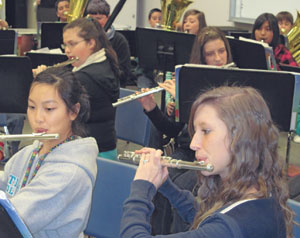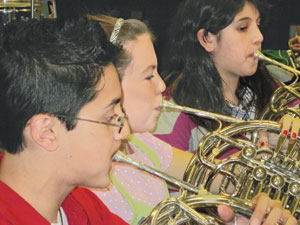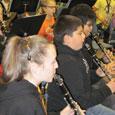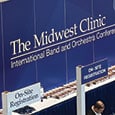 Beginning band is one of the most enjoyable classes I teach, especially because of what these students can accomplish in such a short time. I haven’t, however, always felt this way. After seven years directing a high school band, I accepted a new position that included assisting with a beginning band program. I soon realized that my skills teaching young students had to improve – and rather quickly.
Beginning band is one of the most enjoyable classes I teach, especially because of what these students can accomplish in such a short time. I haven’t, however, always felt this way. After seven years directing a high school band, I accepted a new position that included assisting with a beginning band program. I soon realized that my skills teaching young students had to improve – and rather quickly.
One of my biggest frustrations was that the students would learn correct fingerings for notes, but many of them had difficulty remembering the note names. As time went on I developed a system – Clap, Say, Sizzle, Play – that helped everyone. I can guarantee that your students will improve their note and rhythm comprehension if you apply the four steps in this approach every time you introduce a new line in a beginning band method.
Step One
Students clap and count the rhythm aloud. They say 1-2-3-4 for four quarter notes, wu – uhn for a half note, and wu-uh-uh-uhn for a whole note. A half note starting on count three would is three-ee. Students clap their hands together for the longer note values and move their clasped hands up and down in time to physically feel the beat, which helps them to differentiate between the quarter notes and longer rhythmic values.
For a rest, they say the word rest instead of the count the rest occurs on, which helps them understand that rests are always silent. I insist students open their hands when counting a rest to not confuse rests with notes, and they move their hands up and down in tempo when counting a rest to maintain the feeling of the beat.
 Step Two
Step Two
Say the note names aloud and in time. For example, “Mary Had a Little Lamb,” which is in 4/4 meter, is seven quarter notes followed by a quarter rest. It would be executed as “D, C, B flat, C, D, D, D, rest.”
It is imperative that students playing instruments of the same pitch carry this step out together: concert pitch instruments (flutes, oboe, bassoon, trombone, baritone B.C., tuba, mallets); B instruments (clarinet, bass clarinet, cornet, trumpet, baritone T.C.); E instruments (alto and baritone saxophones); and F horns.
If the students did this simultaneously, the ones with weaker reading skills will become confused when they hear others beside them naming different notes.
Step Three
Sizzle, finger, and tap. I teach three positions to prepare for playing at my school: rest, ready, and play. Students in rest position sit with their backs against the back of the chair, feet flat on the floor, with their instruments in their laps.
They move to ready position by sliding to the front of the chair, sitting up tall, and resting the instrument on one knee. Finally, they bring their instruments up to playing position, which teaches beginners how to be on task, during rehearsals as well as performances. With step three the students perform sizzle, finger, and tap in playing position. To sizzle students make an s or hissing sound while blowing air, something like the sound of a big leaky truck tire. It gives the feeling of correct breath support and the air speed necessary to produce a good sound.
The students sizzle while fingering their instruments, which assists kinesthetic learning. At this point they tap a foot to develop a feel for a steady pulse while playing. I may play a passage on my instrument while the students sizzle, finger, and tap. This is helpful, especially for novice brass players because they can hear correct pitches before actually playing them. It also gives the teacher a chance to model the correct fundamental sound of each instrument. Ideally, the teacher should model a different instrument each day.
Step Four
Play. By this time students have heard and processed the excerpt three times, giving them a significantly higher chance of playing it correctly the first time through. By applying these steps throughout the first year of band, my students’ knowledge and musical memories have dramatically increased. I cannot imagine teaching beginning band any other way.
One other beneficial area is to have beginners write these four steps in their band books. Further, encourage them to follow this process during practice sessions because it reinforces the value of systematic practice. I often give verbal quizzes during class, asking “What is Step One?” “What is Step Two?”
I also have the four steps posted in my classroom for students to refer too. The key is to consistently apply the process so your students develop a clear understanding of how to practice and eventually take ownership of their musical learning. Good luck.





